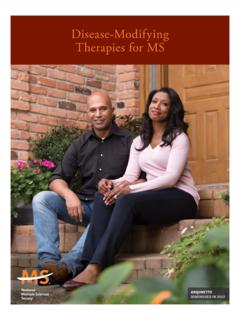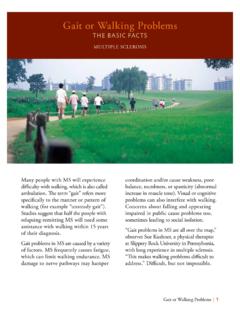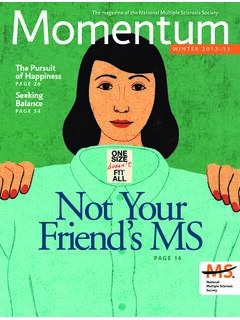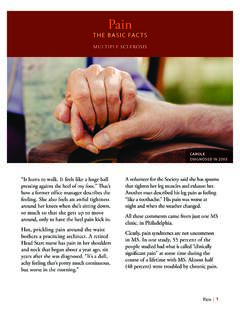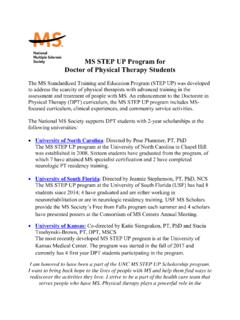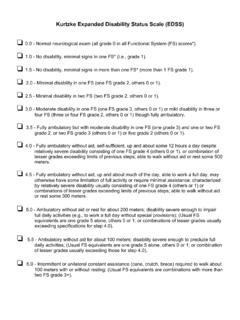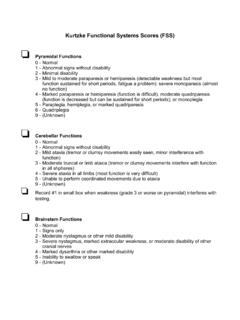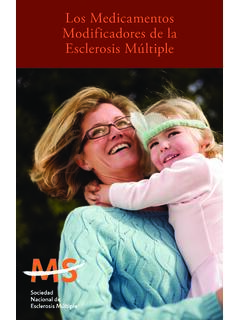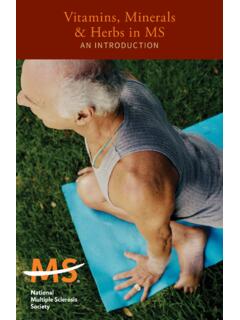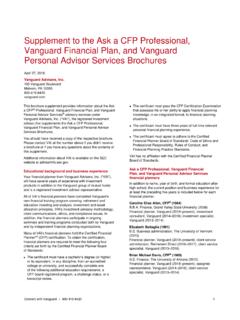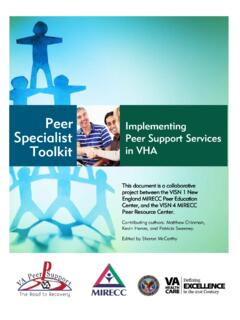Transcription of MATERIALS FOR AQUATIC EXERCISE INSTRUCTORS
1 AQUATIC EXERCISE Programming for People with Multiple SclerosisMATERIALS FOR AQUATIC EXERCISE INSTRUCTORSE dited by Deborah P. Hertz, MPH, National Director, Medical programs Clinical Programs Department National MS Society, New York, NY. : Helen Tilden, RN, National MS Society, Georgia Chapter Clinical Advisory Committee and National MS Society, Special Project ConsultantMiranda Mirsec MA, CES, National MS Society Southern California Chapter Programs Manager, Physical Health and RecreationBrian Hutchinson, MS PT, President, Heuga Center and National MS Society Clinical ConsultantDecember 2003 The Professional Resource CenterThe Professional Resource Center (PRC) of the Clinical Programs Department supports the work of health professionals by providing a range of library and literature search services, as well as information and consultation about the disease and its management, insurance and long-term care issues, and the Society s professional education more information: Toll-free number: 1-866-MS-TREAT (1-866-678-7328) Email: Professional website.
2 Manual has developed over time thanks to the efforts of many Society chapter staff and Divine, TRS, Patricia Finlay, McSP/PT and Helen Tilden, RN, of the Georgia Chapter, developed an aquatics manual in 1993 that was subsequently adopted as a national vision for the new format came from Denise Nowak, RD (certified by the American Council on EXERCISE ) and Miranda Mirsec, MA, CES of the Southern California special thanks is also due to Amy Brown (Mid South Chapter ), Suzanne Carrone (Gateway Area Chapter), Connie Nesbary (Michigan Chapter), and Jo-Ellen Zembruski (New York City Chapter) for their Hutchinson, MS, PT, National MS Society Clinical Consultant and Nancy Holland, EdD, RN, MSCN, Vice President, Clinical Programs Department reviewed this cover photo: Robert, diagnosed in 1990 2016 National Multiple Sclerosis Programming for People with MS ..2 Why Water Works?!? ..2 AQUATIC Programs for People with MS ..2 Benefits and Considerations of an AQUATIC Program.
3 2 Focus on Function ..3 Strategies for Adapting Movement ..3 Using the Physical Properties of Water ..3 Considering Functional Levels ..4 Body Mechanics ..4 Impact Options for AQUATIC EXERCISE ..5 Use of Equipment ..6 General EXERCISE Principles ..8 Exercises for People with MS ..8 Marching/Alternating Knee Lifts ..9 Side Steps ..10 Static Hamstring Stretch ..10 Active Chest Stretch ..11 Trunk Twists Spinal Rotation ..11 Leg/Hamstring Curl ..11 Walking ..11 Pelvic Tilts ..12 Cross Country Ski ..12 Rocking Horse ..12 Straight Leg Walk ..13 Side Tilt/Lateral Weight Shift ..14 Additional EXERCISE Options ..15 Class Structure and Cueing ..20 Lesson Planning ..23 Cueing ..24 Music ..24 Pool Safety and the Environment ..24A National Multiple Sclerosis Society AQUATIC Program ..26 Objectives ..26 National MS SocietyAquatic EXERCISE Programming for People with MS | 2 WHY WATER WORKS?!?Water is a very inviting EXERCISE environment for many people with MS.
4 Cool water temperatures 80-84 degrees Fahrenheit helps to keep core body temperatures low, reducing the chances of overheating. As mentioned in Intro to MS for Fitness and wellness Professionals, overheating can cause temporary worsening of MS natural properties of water including buoyancy or weightlessness combined with resistance create an excellent environment for movement and EXERCISE . Participants can learn to use the properties of water to best meet their specific EXERCISE /fitness needs. Likewise EXERCISE in a pool offers stability and support to practice functional activities such as ambulation. Water often provides support many people with MS need to stand and maintain balance for exercises that would otherwise be too difficult on PROGRAMS FOR PEOPLE WITH MSThe purpose of an AQUATIC recreational program is socialization and EXERCISE , and is intended to meet goals such as increased function and sense of well-being. The AQUATIC class is not intended to be a hands on treatment or therapy.
5 A recreational program is designed to offer people with MS with varying levels of disability or activity limitations an opportunity to participate, including individuals who use assistive devices. The class is taught in shallow water in a group setting with an emphasis on fun and independence. Benefits will vary from individual to AQUATIC program can include aerobic EXERCISE , strengthening, balance training, and stretching in addition to a warm-up and cool-down. Recreation is diversion, rest, relaxation, entertainment, EXERCISE , play and hopefully, enjoyable. The AQUATIC program for people with MS provides an opportunity to maintain mobility, prevent secondary symptoms of MS, maintain or improve flexibility, maximize muscle strength, and maintain or increase endurance recommended pool temperature for an aquatics program for people with MS is 80 84 AND CONSIDERATIONS OF AN AQUATIC PROGRAMFrom Report of the Surgeon General, United States Department of Health and Human Services, (1996), People with disabilities are less likely to engage in regular moderate activity than people without disabilities, yet they have similar needs to promote their health and prevent unnecessary disease.
6 The report also recommends community based programs to meet the needs of persons with disabilities. A community based AQUATIC EXERCISE program is an excellent way to add activity, strengthen the cardiovascular system, reduce body fat, and decrease offers benefits such as: Less energy expenditure required for movements Increased muscle strength due to use of water resistance Opportunity to practice balance and coordination (with more ease than on land) Relaxing effects of buoyancy on the skeletal structure and increased ease of walking in water due to buoyancy Protection from falls ( soft landing) Opportunity to weight bear on the lower extremities Increased circulation A cool EXERCISE environment which can increase endurance with activityAquatic Programming for People with MSNational MS SocietyAquatic EXERCISE Programming for People with MS | 3 Possible considerations may include: Loss of balance due to upward thrust of buoyancy, use of foam equipment or deep water.
7 Fatigue and muscle weakness if water temperature is too warm Effects of incontinence Skin breakdown Decreased opportunity for full weight bearing Fear of waterFOCUS ON FUNCTIONIn general, most movement is beneficial for individuals living with MS. As you focus on developing programs for people with MS, consider movements that address functional factors include: Weakness Spasticity/Spasms Lack of coordination Balance difficulties Tremors Fatigue PainA focus on function in the pool means choosing exercises/activities with the goal of improving coordination, flexibility, balance, muscle strength, endurance, and possibly cardiovascular fitness. Exercises in these areas can improve functional mobility such as transfers, gait and stair climbing. Most importantly, the activities need to be for Adapting MovementComponents of EXERCISE design to be considered when developing a multiple sclerosis AQUATIC class include: Water properties Functional levels defined in the Intro to MS for Fitness and wellness Professionals Body mechanics minor and subtle changes to hand position, body alignment and body composition, alter movement intensity by maximizing or minimizing the effect of water properties Impact options water is an excellent medium for EXERCISE because of the reduced gravitational forces experienced by the body when partially submerged.
8 This produces a lower impact alternative to land-based exercises EquipmentRemember that symptoms of MS are different for each individual and may change daily or weekly. Be sure to discuss potential adaptations of a movement with participants, and always remind them to consult with their physician if symptoms THE PHYSICAL PROPERTIES OF WATER Familiarity with the physical properties of water can help INSTRUCTORS create EXERCISE sessions that are safe, challenging and MS SocietyAquatic EXERCISE Programming for People with MS | 4 Laws and properties include: Buoyancy versus gravity Inertia Resistance Leverage Action and reaction Hydrostatic pressure Surface tension Drag Turbulent flow Speed, power and force TemperatureHere are examples of how to use water properties to maximize pool activities: Change the surface area and speed of movement Change the depth of water altering weight bearing properties Vary impact levels Enlarge a movement, using the property of buoyancy to support the lever Change the planes of movement TravelCONSIDERING FUNCTIONAL LEVELSWhen designing a session keep in mind the three levels of ability (defined in the Intro to MS for Fitness and wellness Professionals) to better meet the needs of all your students/clients.
9 Movements can be altered to match the abilities of individuals. For example individuals interested in improving sit to stand transfers may concentrate more on lower extremity strengthening and stretching , symptoms of MS are different for each individual and may change daily or weekly. Be sure to discuss specific limitations with each student. In addition, involve participants when modifications of exercises are necessary so that they can adapt a movement to best meet their MECHANICSBody mechanics can be a useful strategy for adapting movement. Minor and subtle changes to hand positions, body alignment and length of body levers changes movement intensity by maximizing or minimizing the effect of water properties. Additionally, the impact body composition has on movement execution can assist INSTRUCTORS to make effective movement choices and POSITIONS: Fist hand(s) clenched to form a fist Webbed fingers spread apart and extended Clawed fingers flexed in claw fashion but not clenched as a fist Sliced fingers together and moving hand in chopping movementBODY ALIGNMENTN eutral spine is keeping the vertebral spine in its natural alignment with normal curves in the cervical and lumbar areas.
10 The importance of maintaining torso control and proper body alignment is noticeable with new participants who haven t made the adjustment from movement in a gravity-based environment to a buoyancy-based environment. Adjusting to a new center of gravity (from hip area to lung area) is sometimes difficult for new participants. INSTRUCTORS can help participants by encouraging them to maintain a neutral spine. As participants become more skilled, changing planes can challenge torso is more difficult in water if the depth is above the navel toward the mid-chest area. National MS SocietyAquatic EXERCISE Programming for People with MS | 5 The upward thrust of buoyancy creates an instability and improper foot placement. Bring the class to a more shallow area of the pool to permit control, alignment, and foot strike. The shallow water affords cooling, protection from falls, and body standing alignment: Feet parallel, slightly apart with weight evenly distributed on the heels, outside borders, and balls of the feet Knees soft and relaxed Hips are tucked, slight posterior pelvic tilt The abdomen is flat Chest is high with rib cage lifted Shoulders are level, with shoulder blades flat Head is centered over trunk with chin slightly retracted and ears over shoulder Arms are relaxed with palms facing the sides of the body Spine is in neutral position, meaning when viewed from the side there is an anterior cervical curve or lordosis, followed by a posterior thoracic curve or kyphosis and a lumbar lordosisLEVERSOur body consists of levers.
